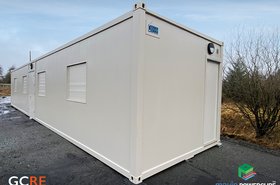Edge data centers will have to be more automated than their centralized “cloud” counterparts. That becomes obvious when you consider the logistics of sending trained support staff to work on the racks, when those racks are installed in 10,000 different cabinets across the country.
What might be less obvious is that the networks underlying the Edge will also have to implement a new level of automation even beyond the automation we already take for granted.
“The networks of yesterday were architected for very different kinds of workloads. Applications have evolved over the last four decades; networks have not evolved," says Cole Crawford, CEO of Vapor IO.
It’s a bold statement - and in some ways it’s almost an admission of defeat from a company which has been pitching micro data centers for the Edge for some years. Frankly, there are a lot of companies like this, including Vapor, EdgeMicro, EdgeInfra, SmartEdge in the UK.
Their idea was that IoT and other low-latency applications needed capacity in containers, at locations like cell towers. Place a shipping container of IT at every cell tower, they said, and it would fill up with IT to support new apps ushered in by of 5G
None of that rapid growth has happened - and it sounds very much like Crawford is admitting that the applications and the networks (and maybe the Edge business models) aren’t up to it. Cell towers don’t have the right power, the networks don’t handle applications the right way.
Despite that, and despite the level of hype around most Edge players, there’s no doubt that in some cases, the Edge is actually happening - and it is having to do unexpected things to the Internet.
The Internet was built for availability, not performance. That’s why streaming media services like Netflix and Amazon Prime have small stacks of hardware in every location they can manage, so their customers can watch videos delivered from a nearby server, without lags and jitter.
It’s also why content delivery networks (CDNs), like Akamai, Cloudflare, and Fastly, have grown up since the turn of the century. In recent years, they have rebranded themselves as Edge networks, promising low latency to customers’ eyeballs, and protection from DDoS attacks.
This article appeared in our Edge Supplement. Read the whole thing here
Running code at the Edge
Initially, Akamai and its rivals had a simple job: speed up static content to users by caching it at the Edge. That changed for video services. Now, as we evolve towards the Edge of recent hype, it’s making a qualitative change: CDN customers are running code at the Edge, so their applications can interact with users directly.
CDNs are well aware of their increasing importance. For many years Cloudflare has marketed itself as a buffer between the user and the service provider, preventing DDoS attacks as well as speeding interactions.
CDNs change towards Edge is more than a rebranding exercise. They are pitching services which can add reliability and intelligence to the Edge.
That claim rang a little hollow on June 8. An outage took down Fastly’s CDN for several hours, and the world looked on aghast, as a failure at this company which few had heard of took down a huge chunk of the visible Internet.
Victims included major news, media and shopping outlets CNN, HBO, the New York Times and eBay. Even Amazon.com suffered, despite the fact that it runs its own CDN, called Cloudfront.
Fastly had shipped out code containing a single error, which was triggered by a customer’s action, instantly ending its service to everyone.
That was a sign. Before the pure-play Edge hype merchants could get their containers to the cell towers, the Edge has already arrived, and we already rely on it.
This was the moment when the world understood that it trusts Edge networks it doesn’t know about, and they don’t always do what we need them to do. They market their reliability, but they are vulnerable.
One week after Fastly failed, Akamai upgraded its Edge network. This was not a kneejerk reaction, though. It was a response to the new Edge, driven by applications, not raw content.
The company already provides “EdgeWorkers” - serverless compute containers that deploy customer code at the Edge. They’ve had an upgrade to have different performance options, and they now have other support functions
Akamai added a key value store, EdgeKV, to give applications at the Edge fast access to data they need. For instance, it could allow content companies to quickly look up their customers’ locations and deliver content which is optimized - and legal under local copyright and other laws.
Akamai also updated its system to optimize API traffic: commands given to Edge applications, which are exploding on the Akamai service. In 2020, Akamai delivered more than 300 trillion API requests - 53 percent more than the previous year.
To accelerate API communications, Akamai has added special-purpose hardware to its Edge nodes, with reserved capacity and prioritized routing to keep transactions happening.
“With this latest platform release, we hope to accelerate this innovation by giving developers the ability to build truly transformative applications at the edge,” said Lelah Manz, SVP of Akamai’s Edge Technology Group. She says that so far customers have been “scratching the surface,” and new ideas will emerge.
CDNs a sticking plaster while we wait for 5G?
For some, the CDN approach, even upgraded in this way, is still a sticking plaster on the old Internet. Will it be able to handle the arrival of fully distributed applications, served to end users via 5G networks?
Cole Crawford believes that the Internet needs a major upgrade. He hasn’t given up on containerized data centers - he’s still got plans to plant them in 36 cities in the US with Zayo providing dark fiber between them.
But his focus is on the network, and he says his new industry group. The Open Grid Alliance (OGA) will fix the Internet.
"We have the technology and capability to fix the broken underlay network, to make it even more reliable and secure,” he says. “The multi-cloud services grid is really about eradicating those deformities in the underlay."
If you think that sounds hugely ambitious, you’re right. Crawford has a history of getting involved in industry groups which hope to change everything. He was there when OpenStack created an open source cloud platform, and when Open Compute proposed open source hardware for data centers.
This time round, he’s got VMware, Dell, MobileEdgeX, and PacketFabrics on board. And, whether OGA ever comes to anything, or not, we may be seeing the first fruits of the new Edge-focused Internet, in Vapor’s latest announcements.
Vapor’s current schtick is the Kinetic Grid, an automated service delivered in the US, using VMware for the application level stuff and Zayo’s dark fiber for connectivity.
According to Crawford and his partners at VMware, the Grid will manage Edge applications across a grid with hardware in (eventually) 36 US cities, prioritizing applications which need low latency, and adapting to local infrastructure failures, delivering the fast response times and resilience promised by CDNs.
The Kinetic Grid relies on an instrumented hardware layers, to real-time status can be passed through an API (Vapor’s Synse) to the VMware platform, which can then orchestrate where and how applications are run.
"A high performance, multilocation. highly-engineered layer 2-and-up network with telemetry is what you get from the Kinetic Grid," VMware VP of product marketing Stephen Spellicy told DCD. "This gets offered to enterprise customers who want to have highly reserved, high-performance edge computing resource available for whatever applications and data they want."
In simulations, the Kinetic grid responds automatically when a hypothetical Edge facility in Atlanta hits trouble. Applications that need low latency, like radio access networks (RANs) are prioritized locally. More forgiving ones, such as video conferencing, can be parcelled off to Pittsburgh.
These constraints are pre-programmed through so-called intent-based networking, and reveal an interesting thing about the new Edge that may be emerging.
Applications which have a human user can be given a slower connection, because human reaction times are in milliseconds. Those dealing directly with machines get the fast lane of the Edge, because they have to get through.
That will also hold true of the CDN approach, where Akamai’s IoT Edge Connect will speed links between sensors and applications.
Crawford reckons that CDNs will deploy their servers on his Kinetic Grid, to benefit from its underlying resilience. Like many other proposed technology upgrades, it’s only likely to succeed if the big players can’t make things work with their existing approaches.





